MULE CROSSING: On the Trail with Mules
By Meredith Hodges

With the hectic schedule of spring and summer slowly tapering into fall, thoughts of cool, refreshing mountain streams, the sight of a massive bull elk, or the quiet majesty of the rugged mountain peaks on a relaxing trail ride, mountain hunt or pack trip begin to ease their way into our minds. What better time to share with your mule or donkey? What better place for him to show you what he was born to do? A mountain trail ride or pack trip are both perfect ways for you to get to really know your Longears and strengthen the bond between you.
Mules are remarkably strong and durable animals, making them excellent mountain partners. The cupped shape of their hooves allows them to track the rough mountain terrain with much more surefootedness than their counterpart, the horse. A mule’s superior intelligence and strong sense of survival help him to carefully negotiate the placement of his feet, insuring the safest ride possible. This is both important and comforting to know when heading for the mountains. The mule’s strength and endurance are sometimes unbelievable, but always dependable. On a hunting trip, he will take you through rough mountain terrain for days then pack out the “elk of your dreams” with the greatest of ease.
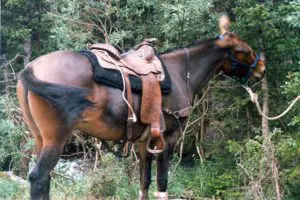
Around the campfire, he is wonderful company on those lonesome mountain nights. His blatant curiosity can make for some fun—and funny— situations, and his loving ways will win your heart. But first and foremost, he is a reliable companion when the going gets tough.
A few years ago, some close muleskinner friends of mine decided to take a hunting trip into the Rocky Mountains. Packing in, the weather was beautiful with warm temperatures, calm breezes, and not a cloud in the sky. After setting up camp and tending to their horses and mules, the hunters set off tracking elk. Hunting was good, but after a few days, the evening brought with it an unpredictable snowstorm of incredible intensity. The hunters crawled from their tents the next morning to discover their camp buried in more than four feet of snow!
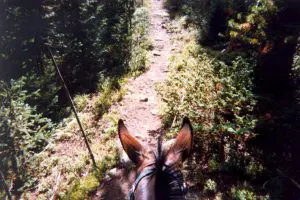
With no chance of the storm lifting, the hunters packed up what they could on their horses and mules and quickly got under way. Since time was of the essence, tents and much of their gear had to be left behind. As they left the campsite, the snow deepened and the terrain underneath was steep, rocky and treacherous. They had gone only a short distance when the snow became so deep and the terrain so hazardous that the horses refused to go one step farther. Anxiety was high when the horses could not blaze a trail out. The hunters were worried they wouldn’t make it off the mountain alive.
In the face of this great danger, my friend asked his trusted mule, Goliath, to break trail for the others. With slow, careful, deliberate steps, this well-trained, loyal mule led them all down the mountain to safety. Once there, they freed their trucks and trailers, which were buried in snow, loaded them up, and made their way back to the lowlands to safety. The storms on the mountain worsened and it was spring before the hunters could return for the rest of their gear, but they were eternally grateful to Goliath the mule for leading them safely down the mountain!
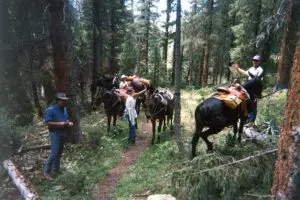
There are many stories like this one, where mules and donkeys have emerged as heroes in precarious situations. However, if you prefer not to take risks like my hunter friends, there are other less daunting activities you can enjoy with your donkey or mule.
Why not take your longeared companion along to the mountains for a hike or a picnic? He would thoroughly love just being with you in those beautiful surroundings. While you walk the trails, enjoying the marvels of nature, your donkey or mule can carry the lunch essentials. While you enjoy the wildflowers or try your hand at fishing a mountain stream, you can be confident that your Longears will enjoy the peaceful solitude and be able to stay out of serious trouble at the same time.

If you question taking excursions such as these with your longears because of a lack of training, there are fellow Longears lovers who can help you. All over the United States, excellent mule trainers are available to help beginners. A Longears lover once told me that his love for burros and mules began years ago when he found Dusty, a three-month-old wild burro caught in a blizzard. He took her home and cared for her, and, a year later, he entered her in the National Western Fall Classic Donkey and Mule Show. He and Dusty were awarded the title of Reserve Champion Donkey of the Show! Ever since, he has sought to help others enjoy Longears and horses in any way he can. In addition to breaking and training wild mustangs at his Medicine Bow Stables, he has included free clinics for burro owners to teach them how to handle and care for their animals.
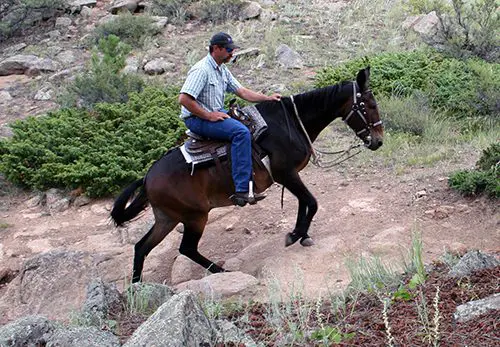 We are fortunate to be able to share our time with such intelligent, tough and durable equines as our beloved mules. But you should also remember to do your part in the relationship. Be patient and willing to take the time to allow your relationship to grow and for training to become solid before you indulge in the challenges that trail riding can present. Plan ahead and scout the locations where you desire to ride. With the growth of urban populations, open areas that welcomed riders in the past are not as numerous as they once were. Many areas now welcome hikers and even bicycles, but not equines. Find the designated trails and camp grounds that will accept equines when planning your treks.
We are fortunate to be able to share our time with such intelligent, tough and durable equines as our beloved mules. But you should also remember to do your part in the relationship. Be patient and willing to take the time to allow your relationship to grow and for training to become solid before you indulge in the challenges that trail riding can present. Plan ahead and scout the locations where you desire to ride. With the growth of urban populations, open areas that welcomed riders in the past are not as numerous as they once were. Many areas now welcome hikers and even bicycles, but not equines. Find the designated trails and camp grounds that will accept equines when planning your treks.
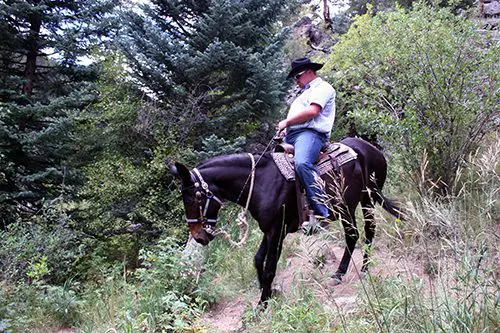 Even a ride that is planned to be short can turn into challenge if the weather changes suddenly, so be sure to plan for the worst case scenario. Tack up your equine in comfortable tack and equipment that fits like a glove. I like to ride with a crupper because it will hold the saddle in the correct placement when adjusted correctly and will allow for full range of movement, particularly behind when climbing uphill. If you use a breast collar, make sure it is loosely fitted so it does not pull your saddle forward and into the shoulder blades. Be sure to pack your saddle bags with the barest necessities for any ride far from home: Compass, water, rain gear, a Swiss Army knife, buck knife, hoof pick, lighter, fence pliers, Granola Bars or Trail Mix, a sleeping bag, a warm coat, Bear Spray and a First Aid Kit (at the very least Gauze, Vet Wrap and Neosporin).
Even a ride that is planned to be short can turn into challenge if the weather changes suddenly, so be sure to plan for the worst case scenario. Tack up your equine in comfortable tack and equipment that fits like a glove. I like to ride with a crupper because it will hold the saddle in the correct placement when adjusted correctly and will allow for full range of movement, particularly behind when climbing uphill. If you use a breast collar, make sure it is loosely fitted so it does not pull your saddle forward and into the shoulder blades. Be sure to pack your saddle bags with the barest necessities for any ride far from home: Compass, water, rain gear, a Swiss Army knife, buck knife, hoof pick, lighter, fence pliers, Granola Bars or Trail Mix, a sleeping bag, a warm coat, Bear Spray and a First Aid Kit (at the very least Gauze, Vet Wrap and Neosporin).
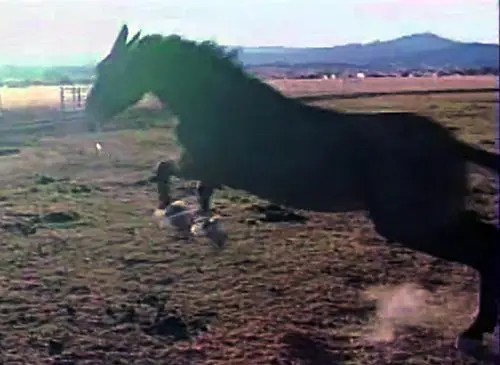 If planning an overnight trip, you will probably need a pack mule, or horse, to carry the extra food and additional necessities you will need like tents, blankets, sleeping bags, more food, extra clothes, High Lines and extra halters, and food for your equines. Lots of places will not allow your equines to graze in the parks, but some do. I do not like using picket lines where the equine is tied low with a halter, or with a rope around a foot. I do not like to use hobbles either (Mules can run off in hobbles with no trouble at all!). It is too easy for equines to get tangled up or injure themselves when they are restricted this way. They can get sprained tendons and ligaments, or severe rope burns that will leave them scarred for life. I prefer to bring their favorite horse “friend” along and tie the horse, and mules that tend to wander, to a High Line. Most of the mules can be allowed to run free and won’t leave your camp with the horse there, but do not leave halters on them. Again, they could become tangled up and injure themselves. If you have spent adequate time during training to build a solid relationship with your mules, they are much less likely to wander off and get lost. They will choose to stay near you.
If planning an overnight trip, you will probably need a pack mule, or horse, to carry the extra food and additional necessities you will need like tents, blankets, sleeping bags, more food, extra clothes, High Lines and extra halters, and food for your equines. Lots of places will not allow your equines to graze in the parks, but some do. I do not like using picket lines where the equine is tied low with a halter, or with a rope around a foot. I do not like to use hobbles either (Mules can run off in hobbles with no trouble at all!). It is too easy for equines to get tangled up or injure themselves when they are restricted this way. They can get sprained tendons and ligaments, or severe rope burns that will leave them scarred for life. I prefer to bring their favorite horse “friend” along and tie the horse, and mules that tend to wander, to a High Line. Most of the mules can be allowed to run free and won’t leave your camp with the horse there, but do not leave halters on them. Again, they could become tangled up and injure themselves. If you have spent adequate time during training to build a solid relationship with your mules, they are much less likely to wander off and get lost. They will choose to stay near you.
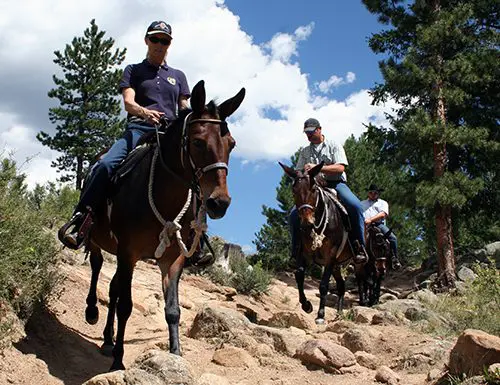 If you can, choose a place where you can establish a base and park your truck and trailer. You can then tie them on a High Line during the evening and put them back into the trailer for the night. This might be better if you are an area where there are a lot of large predators. Just don’t leave the truck and trailer windows open so a predator can get in. Stock trailers are the best for this purpose since they also have more room in them and are fully enclosed. Any food that could be attractive to predators should be mounted high in a tree, at least 50-100 yards away from your camp and your equines.
If you can, choose a place where you can establish a base and park your truck and trailer. You can then tie them on a High Line during the evening and put them back into the trailer for the night. This might be better if you are an area where there are a lot of large predators. Just don’t leave the truck and trailer windows open so a predator can get in. Stock trailers are the best for this purpose since they also have more room in them and are fully enclosed. Any food that could be attractive to predators should be mounted high in a tree, at least 50-100 yards away from your camp and your equines.
Getting the proper in-depth training for your donkey, or mule, can only enhance your relationship with them and in turn, they will enrich your life. This year, why not take the time to really get to know these remarkable animals by letting them share in the fun, be it hiking, hunting, packing, or picnicking. The life you enhance may be your own!
To learn more about Meredith Hodges and her comprehensive all-breed equine training program, visit LuckyThreeRanch.com, MEREDITH HODGES PUBLIC FIGURE Facebook page, or call 1-800-816-7566. Check out her children’s website at JasperTheMule.com. Also, find Meredith on Pinterest, Instagram, MeWe, YouTube and Twitter.
Covered in TRAINING MULES & DONKEY: A LOGICAL APPROACH TO TRAINING, TRAINING WITHOUT RESISTANCE and EQUUS REVISITED at www.luckythreeranchstore.com.
© 2013, 2016, 2024 Lucky Three Ranch, Inc. All Rights Reserved.





Pam Chappel
January 24, 2021 @ 11:13 am
Hello, I am a 73 old woman who has been riding mules for 20yrs. Still consider myself and intermediate rider. I have a “new to me” john mule who is 9yrs, 14h. He was packed and ridden all last summer. Good ground manners, ok neck rein, learning leg pressure. Smart, willing, and good on trails. I like him very much. The problem – he is heavy on the front end and I frequently feel him slam his right foot down at a slow walk. Going down hill he really jams that front end and it nearly jars me to death.. I am having an equine chiropractor out this week to see if problem may lie there. But if not, is there a way to correct this. If so, I know you can not possible tell me in an email, but if it is correctable, who do you suggest. I live in MO and spend the winter in AZ. I like him well enough that I would be willing to spend to have him where I am not jarred to death when riding him. Any suggestions would be greatly appreciated.
Thank you.
Pam Chappel
Bailey Folker
January 27, 2021 @ 10:50 am
Hello Pam. You can email Meredith at meredith@luckythreeranch.com and she can send you information on how to develop core strength in a good postural balance.